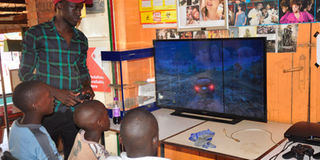Earn from a gaming parlor

David Ongom guides children at a gaming parlor in Kampala. Due to high pricing of the top rated games, most people cannot afford them. That is why they mostly rely on the local gaming centres. PHOTO DAVID S. MUKOOZA
What you need to know:
The thrill and excitement that overwhelms players enjoying hi-definition games on large screens draws customers to gaming parlors. David Ongom gives tips on how to start such a business.
You can make some money from the addictions and obsessions of video game players. These players are willing to part with some money to enjoy these expensive games that they cannot afford.
These days, people visit video game parlors not only for gaming, but also borrowing a few leading games that they don’t possess. They may even come to your outlet to upgrade their old gaming box at a small fee.
Since these kind of customers would be bored with the old collection of games, you ought to invest in stocking the latest collection at regular intervals.
Gaming is a popular activity among people all across the world and Uganda is not an exception here. Due to high pricing of the top rated games, most people cannot afford them. That is why they mostly rely on the local gaming centres. So, you can exploit this opportunity of launching a small gaming centre which would not require any particular qualification or training but earn you a good profit at the end of every month.
What is required?
According to David Ongom who operates a gaming parlor, you need a video game console. A video game console is a computer device that outputs a video signal or visual image to display a video game that one or more people can play. This console comes with control pads that the people playing the games use to command the game or characters.
He says the console comes with a maximum of two pads but since some games require four players, then one can buy extra pads.
Ongom says the other very important thing is the screen where the games are displayed. He says one can start with two screens or even one screen depending on the demand.
Ongom says having a gaming parlor means you need to have the games such that they are uploaded on the console for people to play.
Some of the most played games are “Fifa” - a soccer game and blar - a race game that took over the popularity of a game called ‘need for speed’.
You must have a steady power supply because without power, there won’t be any games.
Capital
With a capital of Shs5 million Ongom says one can start a video gaming parlor. This will include a console that is PS 3, which costs approximately Shs1.3 million, 2 size 32-inch screens each at about Shs900,000. But he advises one to buy bigger screens because it gives the game herb or the parlor impression, something which attracts more clients thanks to the clarity and the size of display. The capital will also include the control pads which cost approximately Shs80,000.
Profitability
The profit from this business largely also depends on your clientele. Ongom says the good thing is that the gaming parlor has no age.
You will find people across different age groups playing these games as a way of relaxing. That is how Ongom earns Shs50,000 a day, about Shs1.5million in a month. If you reduce expenses with other factors held constant, one can make a profit of Shs1 million.
Challenges
One of the most challenging thing is security. These consoles and the screens are admired by thieves and many people who dream of owning them. Since they are expensive, so thieves will always threaten to break into the parlor. Therefore, one has to invest a lot in the security of the place.
Secondly, some customers steal the control pads and if you have a big gaming parlor, one can even steal the console because monitoring becomes hard especially if there are many people.
The video gamers also vandalise this equipment by dropping it down carelessly. So, be ready to engage in repairs which come at a big cost due to the technology used to make them.
You must also keep updating the games. For example the most common game “Fifa” is updated every six months,” Ongom says.



